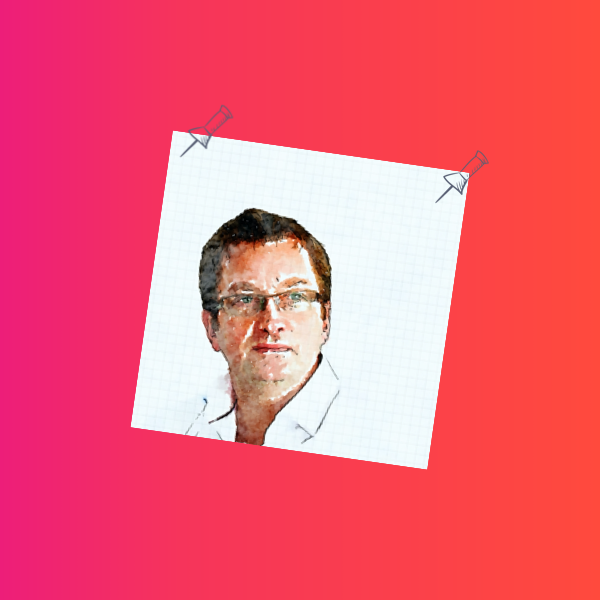Consultant Spotlight: Mike Straw, CEO & Founder
Leadership Blog | 4 minute read

Written by Mike Straw

Consultant Spotlight – In this series we give you an opportunity to get to know our extraordinary consultants a bit better. Find out, in their own words, what fires them up, what makes them tick and the biggest lessons they’ve learnt along the way. First up, is Mike Straw, our CEO and Founder. Take it away Mike…
"
I recently had the pleasure of being invited onto Adam Pacifico’s popular podcast, Leadership Enigma, to discuss the Achieve Breakthrough approach to leadership.
I found it fascinating to reflect back on my own journey and chat with Adam about how the breakthrough way of thinking came about – and what it means to achieve breakthroughs by design.
Where it all started
When I first left university and took the rather unsexy role of working in a factory that made Quality Street tins, what I saw was a reasonable salary and a company car which would be perfect to tow my boat to various sailing competitions around UK and Europe - to me back then owning a hatchback Rover was like owning an Aston Martin with a built-in martini maker!
But I settled in well enough, and in an attempt to boost my learning the company put me on a course called Breakthrough Thinking run by Oxford-based company Breakthrough Technologies.
On the right course
From the moment they said, “people base themselves on stories of the past and bring those stories forward into the future”, my mind was blown, and a fire was sparked within me that has been burning ever since.
It seemed so clear to me. People always try to build for tomorrow using yesterday’s results. At the time though, I’d never thought about it quite like that before.
When I returned to work I only saw the workplace in terms of how I could increase productivity. I was realising how previous failed attempts to increase it had only been stonewalled by false assumptions and stories from the past.
I now had the itch to pursue this further. So, a week later I rang Breakthrough Technologies, told them how irresponsible it was to just tease me with a two-day workshop, and I asked if I could work for them.
They said yes 25 years ago, and since then we’ve bought Breakthrough Technologies and turned it into Achieve Breakthrough. I’ve dedicated my life to building on these philosophies and unlocking the potential in people to help them achieve what they previously thought impossible.
Breakthroughs through conversation
It didn’t take me long in this line of work to realise that the conversation that we are determines the results we can achieve.
I would often go to organisations and they would tell me they wanted a mindset change or a culture change or everybody’s favourite: “we want to boost morale”. So, I’d ask them “where is morale?”
Of course, unless you have an employee whose name is Morale, it’s impossible to point to. That’s because morale is actually a conversation. It’s a conversation we have in our heads or out loud about what is and isn’t possible to achieve within the organisation.
In the same vein, culture change and mindset change are conversations. So to change mindset and culture you first need to alter the conversation and the stories an organisation orientates itself around.
Our context is decisive
If being a breakthrough conversation can shape cultures and mindsets, understanding the context of those conversations can move mountains.
I’ve often found, even to this day, that there’s an addiction epidemic in most organisations. They’re addicted to getting results, analysing them, then putting in a new process or system to get a different outcome.
But all of this happens inside of a context – the context here meaning the human environment that governs the success of any process or system. And this context is any organisation’s frame of reference – the hidden assumptions, beliefs and stories that either limit or propel the organisation forward.
In my view, context is fundamentally decisive. It frames what is possible and not possible and most organisations don’t know how to shift it. But in order to achieve breakthroughs you need to shift this context.
Resisting the super magnet
Your context is determined by external factors and what you or your organisation says about those factors.
Let’s say someone invents a new technology and one of their competitors explains that tech away, saying “it won’t work here for reasons X, Y and Z.” Their arguments might well be formed from an unhelpful internal dialogue.
The status quo is a super magnet, an immune system, even in the most enlightened organisations, drawing organisations into the past even if it flies in the face of whatever’s happening in the market conditions.
But if we can’t shift our own internal dialogue in relation to the marketplace then we’ll be left behind. The next impossible thing will be invented. The question is whether it will come from your competitors or you - and that’s going to come down to the power of context.
Breakthrough by design
Throughout the past 25 years of working with organisations to achieve breakthroughs, I’ve asked countless people to give me an example of a breakthrough. The favourite that always crops up is getting a man on the moon.
I can’t argue with that. When JFK said ‘we’re going to land on the moon’, NASA didn’t even know if the moon’s surface was solid, let alone if we could land on it. But seven years later we flew to the moon, and Armstrong uttered those immortal words.
People say it’s a triumph of technology, but in my view it’s actually a triumph of a thinking process. And that thinking process is what we call breakthrough thinking.
What this means is taking the seemingly impossible, making it possible, and then making it a reality. The first step to breakthrough thinking is letting go of our conventional wisdom and cutting assumptions loose.
We need to unlearn our winning moves. When chess grandmaster Garry Kasparov was asked how he changes his winning tactics to prevent them becoming predictable, he said, “You’ve got to escape the gravity of success”.
There’s a fine line between our experience and our baggage, and there’s a beauty to getting free of the assumptions that own us. If you can achieve that, you can achieve breakthroughs.
I’ve also long since realised that whilst most organisations are looking for high-performance and productivity, what they really need is the vitality to give them the energy, strength (and courage!) to challenge the status-quo super magnet.
"
Looking to unlock your full potential? Get in touch to explore how we can help you ignite your ambitions.
Published 31/08/2021
Subscribe by Email
Achieve more breakthroughs. Get expert leadership ideas, insights and advice straight to your inbox every Saturday, as well as the occasional bit of news on us, such as offers and invitations to participate in things like events, webinars and surveys. Read. Lead. Breakthrough.
Tags
- Attracting talent
- Behaviour change
- Blended Learning
- Breakthrough Thinking
- Business partnering
- Career planning
- Change management
- Collaboration
- Communication
- Competitive strategy
- Creativity
- Decision making
- Developing middle management
- Developing millennials
- Developing talent
- Employee engagement
- Entrepreneurship
- High performing teams
- Hiring
- Human Resource Management
- Innovation
- Leadership development
- Learning technology
- Managing people
- Managing uncertainty
- Managing yourself
- Mergers & Acquisitions
- Mindset
- Motivating people
- Negotiation
- Organisational culture
- Organisational development
- Organisational values & purpose
- Performance management
- Productivity
- Programme Management
- Retaining talent
- Strategic thinking
- Strategy
- Strategy execution
- Succession planning
- Team development
- Work-life balance
Related posts
Leadership Blog
How to lead when judgement is instant and opinions are everywhere
Achieve Breakthrough | 06/01/2026
Leadership Blog
Leadership burnout: Expanding bandwidth to thrive through complexity
Achieve Breakthrough | 16/12/2025
Leadership Blog
What triggers you as a leader, and how to work with it?
Achieve Breakthrough | 09/12/2025
Leadership Blog
Why it’s impossible to lead with one foot still in your old role
Achieve Breakthrough | 03/12/2025
